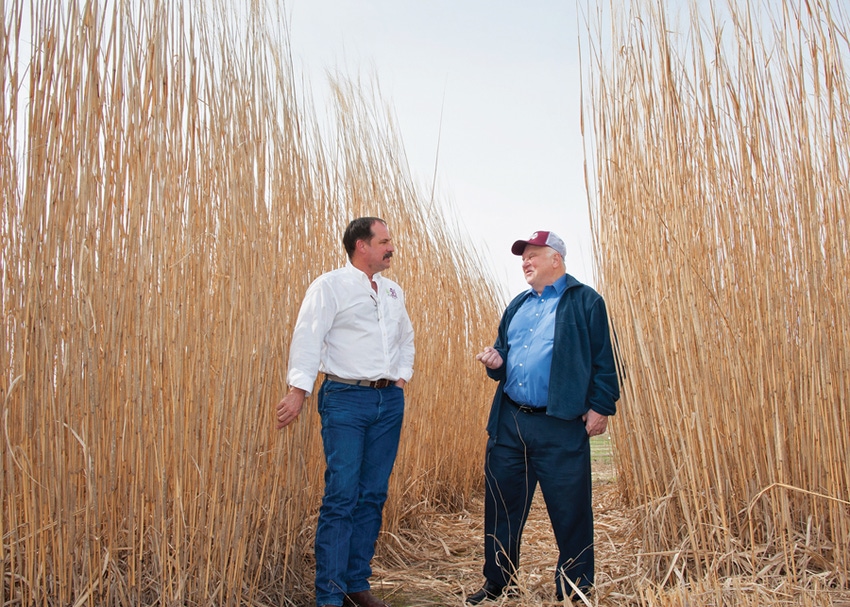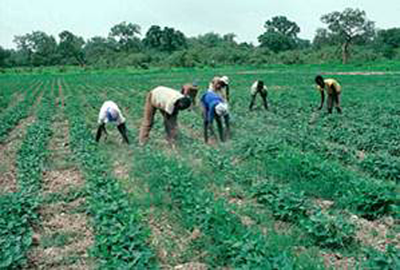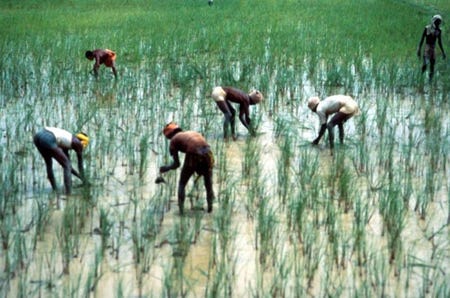
Ag chemicals, GMOs critical to increase world food output
Herbicides, insecticides, and GMO crops will be vital to meeting the needs of another two billion people on planet Earth by the year 2020, says Leonard Gianessi, consultant for the CropLife Foundation, Washington, D.C. “Make no mistake about it, these materials are essential for controlling the weeds, insects, and diseases that greatly reduce the world’s food supply,” he said at a Mississippi State University conference.

Uncontrolled weeds are a major contributor to world hunger, says Leonard Gianessi. “Do something about that, and you will take a major step toward alleviating this problem.”
And he says, that’s why herbicides, insecticides, and GMO crops will be vital to meeting the needs of another two billion people on planet Earth by the year 2020.
“Make no mistake about it, these materials are essential for controlling the weeds, insects, and diseases that greatly reduce the world’s food supply,” he said at a Mississippi State University conference, “The Importance of Pesticides for Feeding the World.”

TERESA GAMMILL, assistant vice president for research at Mississippi State University, was among university officials welcoming Leonard Gianessi to the campus.
“We need to make sure policymakers realize that there is going to be a tremendous demand for pesticide use around the world, and that their support is important to feed their people,” says the consultant for The CropLife Foundation, Washington.
“We’ve got to make people understand — not just the decision-makers, but the general population, too — that these technologies are really important for food security and overall world security. “
Bill Herndon, MSU vice president for agriculture, forestry, and veterinary medicine, said Gianessi’s work “on the front lines of crop production and food issues” is helping to create awareness of the role of technology in meeting global food needs.
“His is a scientifically sound message about the importance of agriculture to food security,” said David Shaw, MSU vice president for research and development.
Much of the world population growth that will add another 2 billion people over the next 40 years is occurring in countries that are also experiencing rapid economic growth and increased urbanization, Gianessi says. “Middle class populations are growing, and their diets are changing. This will put pressure on the food supply and the need for utilization of pesticide technologies.”
China, the largest country in the world in terms of population with 1.3 billion people, is rapidly changing from a rural, agrarian society to urban, he says, and will add another 700 million people by 2050.
“The Chinese have grown rice for centuries, and with a predominantly rural population, they could enough people in the fields to chop out weeds by hand. To accomplish adequate weeding of rice by hand today would take the equivalent of every person in the country spending a day of labor just weeding. In today’s industrialized China, that is no longer possible.
“Their weed scientists in China started to look seriously at herbicides 15 to 20 years ago, and these materials have freed hundreds of thousands of people for other labor. Herbicide adoption has been very rapid; in 2005, about 80 million hectares treated; today, over 100 million.
China No. 1 in world pesticide sales
“The rice water weevil, first reported in China in 1988, was causing losses as high as 80 percent. Insecticides are now being used on a large scale to attack this pest, which came from the U.S.”
Uncontrolled wheat rust was causing losses of 1.3 million tons yearly in 2002, GIanessi notes. “Now they’re treating 6 million hectares with fungicides and they’re self-sufficient in wheat. “As a result of herbicide, insecticide, and fungicide use, we now see fields free of weeds, insects, and diseases, and China is self-sufficient in rice. That could not have been possible without these technologies.”
China now ranks No. 1 in the world in pesticide sales, expected to reach $10.5 billion yearly by 2021.

HAND WEEDING of crops takes millions of hours of labor in Africa. — CropLife photo
India also has traditionally used a lot of hand weeding — “an enormous use of human labor, but it was never adequate. India began using herbicides and is now one of the major markets for these materials, with $400 million in sales in 2010 and increasing 20 percent to 30 percent yearly.”
Pulse crops (beans, mung beans, peas) are a major source of protein for the Indian population, Gianessi says, and the country is the largest producer of pulse crops in the world. “But yields were terrible because of weeds and insects. As people had more income, demand increased and they were importing these crops. Research showed that with herbicides, insecticides, and fertilizers they could triple their current production.”
Bangladesh, a small country estimated to have 70 million more people by 2050, was already growing two crops per year on every hectare of farmland, he says, and needed to increase rice production.
“There was a huge gap between what they were producing and what they could grow by using technology. Half the gap was due to poor weed control — 43 percent to 51 percent crop losses. Herbicides increased yields, and lowered costs; net income for farmers using herbicides increased by 116 percent.”
PLEASE ALSO READ: Real threat to food security is ginned-up panic over GMOs
China and India are seeing a huge movement from subsistence living to middle-class living, Gianessi says. “This will put tremendous pressure on the food supply. Meat consumption is growing exponentially,. Beef/pork/poultry production are huge, which is increasing demand for animal feeds. That’s where the U.S. comes into the picture. Our agricultural exports to China have been one of the really positive stories in our economy and in the agricultural sector.
“Soybean exports to China total 895 million bushels yearly, 50 percent of all the soybeans we export, and 25 percent of our total harvest.”
Herbicides key to soybean yield increases
Those exports have been made possible by major increases in soybean yields in the U.S., Gianessi says. “Since 1976, herbicide use in the U.S. has been a key component of soybean yield increases, with 95 percent to 98 percent of all soybean acres now treated with herbicides.

HERBICIDE USE can make a tremendous difference in soybean yields. — CropLife photo
“Each acre of cropland in the U.S. contains 50 million to 300 million buried weed seeds, which an be viable in the soil for 20 to 30 years or more. This is a buried menace. Without herbicides, we’d have massive carpets of weeds taking an enormous toll on soybean yields.”
For those who oppose agri-chemicals, he says, “There is a non-chemical alternative: cultivation. But research at
Michigan State University has shown that in too many cases, weather or other problems prevent timely weed control operations with cultivation alone. If the U.S. were to grow soybeans without herbicides, every third year we’d be losing, the amount of soybeans we sell to the Chinese. That’s unacceptable. The world’s counting on us. We can’t take this kind of risk.”
The U.S. has, over the years, faced many of the same issues with weeds and other crop pests that other countries are now coping with, Gianessi says.
ALSO OF INTEREST: Global food security should emphasize science, trade, business
“The development and adoption of increasingly effective herbicides, insecticides, and fungicides allowed farmers to step up and meet the challenge, increasing output by a factor of five, at a time when population increased by only a factor of three. We had enough to feed not only our own people, but more that we could share with the rest of the world. We’re growing five times as much on our farms with far less labor, and we’re doing it across a broad spectrum of crops on 20 percent less land.”
Rice in the U.S. has been a major beneficiary of herbicides, he says. “From 1900 up until the 1950s, without weed control, yields were about 1 ton per acre. With herbicides, yields have more than doubled.”
Agri-chemicals bring substantial yield increases
Brazil went from near zero in soybean production in1952 to become “a world powerhouse” for that commodity, Gianessi says. “But all that was threatened in 2001 by soybean rust, which had spread throughout the country by 2003, in some instances claiming up to 75 percent of the crop. Their fungicide market went from $25 million to $1 billion in one decade, and Brazil is now the single largest market globally for soybean fungicides. The ‘Brazilian soybean miracle’ has been possible because of fungicides.”

MUCH OF INDIA'S rice crop is hand-weeded, but herbicides and other technologies are steadily gaining ground. — CropLife photo
Maize is the main food for 50 percent of the population in Africa, he says, but average yield was only 1.6 tons per hectare, compared to the world average of 4.5 tons. “With pesticide use, yields have gone up 27 percent to 47 percent.
“Weeding of crops in Africa has historically been done by women and children. Estimates are that there are 100 million women spending 20 billion hours weeding crops. But even that is not enough — estimates are that 40 billion hours are needed just to control weeds.
“CropLife Zambia has trained people to recognize weeds and to apply herbicides with backpack sprayers. Once people see how effective this is, they want to use it. CARE Zambia asked to evaluate program, and reported a tripling of maize yields where herbicides have been used. It has provided jobs and income for the applicators, and it has freed millions of women for other work.
“This technology is being adopted not because some deep thinker at the United Nations or World Bank is saying to adopt it — but because farmers are seeing what their neighbors are doing and what a difference this technology can make.”
READ MORE: Those awful farm subsidies: What's food security worth?
Africa is being transformed from rural to urban, Gianessi says. “Cities are growing exponentially. There are now 300 million in urban areas, with projections of 1 billion by 2050 — faster growth than in China. Some of the fastest-growing economies in the world are in Africa, and more people are finding jobs in industrial sectors.
“This is resulting in consumption of more and different foods. In sub-Saharan Africa, potato consumption has increased by a factor of three over the past 20 years, but yields have remained basically stagnant. So, they were tearing out trees to plant more acres to get more yield — that is not sustainable agriculture. With fungicide use, potato yields have been increased by 224 percent.”
Without pesticides, Gianess says, China’s rice production would be reduced by 67 percent, wheat by 57 percent. “But the scenario of millions of hungry Chinese is being avoided with the use of these technologies.”
Information on the work of the foundation can be found at
CropLifeFoundation.org, where there is also a link to Gianessi’s blog: http://pesticideguy.org
About the Author(s)
You May Also Like



